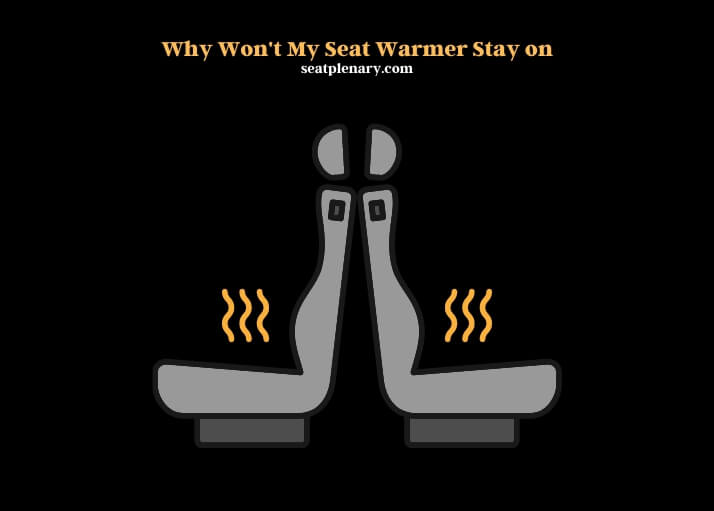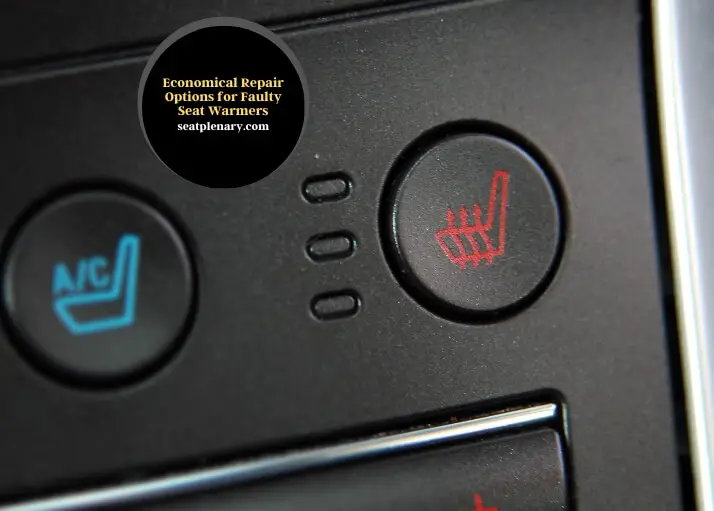Seat warmers in vehicles may not stay on due to various issues such as electrical problems, wiring faults, or malfunctioning control modules. These components are crucial for the consistent operation of seat warmers.
Seat warmers, an essential comfort feature in many modern vehicles, rely heavily on the vehicle’s electrical system. Electrical issues can range from simple problems like loose connections to more complex issues such as short circuits or blown fuses. Wiring faults are also a common culprit, especially in older vehicles where wires may have degraded over time.
The control module, which regulates the temperature and operation of the seat warmer, can malfunction, leading to inconsistent or non-functional seat warmers.

Regular maintenance and timely checks can help identify and rectify these issues before they escalate. For instance, checking the fuse responsible for the seat warmer can often reveal if a blown fuse is the cause.
Ensuring that all connections are secure and intact can prevent many electrical issues. In cases where the problem is not immediately apparent, professional diagnostic tools can be invaluable in pinpointing the exact cause.
These potential issues can help vehicle owners maintain the functionality of their seat warmers and address problems more efficiently, ensuring a comfortable driving experience in colder conditions.
Diagnosing Seat Warmer Failures
Electrical issues, wiring problems, fuse malfunctions, and control module faults are often the culprits behind seat warmer malfunctions. Electrical issues can range from simple loose connections to more complex problems like short circuits. Wiring problems are also common, especially in older vehicles where wires may have degraded over time. Fuses can blow due to overcurrent, which prevents the seat warmer from functioning.
Control module faults, which are the brain behind the seat warmer’s operation, can lead to inconsistent performance. Regular maintenance checks can help identify these issues early, preventing more significant problems down the road.
Troubleshooting Inconsistent Seat Warmer Performance
When facing inconsistent seat warmer performance, following a structured troubleshooting approach is vital. Start with the diagnostic procedures outlined in the vehicle’s user manual. These guidelines are specifically tailored to your car’s model and make. If the manual’s steps don’t resolve the issue, a professional assessment might be necessary. Technicians can perform electrical testing to pinpoint the exact cause of the malfunction. This step-by-step approach ensures that all potential problems are addressed systematically.
Vehicle Age and Seat Warmer Reliability
The reliability of seat warmers is significantly impacted by the age and usage of the vehicle. Over time, wear and tear on the vehicle’s components can lead to decreased performance. The longevity of these components varies, with some models being more prone to issues than others.
Regular maintenance and understanding your vehicle’s history can help mitigate these problems. Being aware of model-specific issues can guide owners in taking preemptive measures to ensure the longevity of their seat warmers.
Comparative Analysis of Seat Warmer Technologies
Seat warmer technologies vary significantly across different car models. This section provides a comparative analysis of these technologies, focusing on manufacturer specifications, technology variations, heating element types, and user reviews.
Comparison of Seat Warmer Features Across Various Car Models
| Car Model | Heating Element Type | Temperature Settings | Additional Features | User Rating |
| Ford Explorer | Carbon Fiber | 3 Levels | Auto Shut-Off, Rapid Heating | 4.6 |
| Toyota Camry | Wire-based | 5 Levels | Energy Efficient, Longevity | 4.4 |
| Honda Accord | Alloy-based | 4 Levels | Programmable Settings | 4.7 |
| Chevrolet Malibu | Carbon Fiber | 3 Levels | Integrated Safety Features | 4.5 |
| BMW 3 Series | Wire-based | 5 Levels | Luxury Feel, Custom Settings | 4.8 |
Economical Repair Options for Faulty Seat Warmers
When it comes to repairing faulty seat warmers, there are several cost-effective solutions. DIY fixes can be a good option for those with some technical knowledge. However, for more complex issues, professional repair services might be necessary. The costs involved is crucial for making an informed decision.

Average Repair Costs for Common Seat Warmer Issues
| Issue Type | DIY Cost | Professional Repair Cost |
| Wiring Repair | $20 | $100 |
| Fuse Replacement | $5 | $50 |
| Control Module Fix | $50 | $200 |
FAQs
Is Seat Warmer Malfunction Linked to Battery Health?
Seat warmer issues can sometimes be traced back to the vehicle’s battery health. A weak or failing battery might not provide enough power for the seat warmer to function correctly. This is particularly true for vehicles that have numerous electrical accessories demanding power. Regular battery checks and ensuring it’s fully charged can help maintain the efficiency of your seat warmer.
Can Seat Covers Affect Seat Warmer Functionality?
Using certain types of seat covers can impact the functionality of seat warmers. Thick or insulated covers might hinder the heat transfer, making it seem like the seat warmer isn’t working. It’s advisable to use seat covers that are compatible with seat warmers, preferably those that are thin and heat-permeable.
Do Seat Warmers Have a Lifespan?
Like any other component, seat warmers have a lifespan. Over time, the heating elements can degrade, especially with frequent use. This degradation can lead to inconsistent heating or complete failure. Regular maintenance and gentle use can extend the life of your seat warmer.
Could Software Glitches Affect Seat Warmer Operation?
In modern vehicles equipped with advanced computer systems, software glitches can affect the operation of seat warmers. These glitches can cause irregularities in how the seat warmer functions. In such cases, a software update or reset by a professional might be necessary to resolve the issue.
Is There a Safety Feature That Turns Off Seat Warmers Automatically?
Many modern cars come with a safety feature that automatically turns off the seat warmer to prevent overheating. If your seat warmer shuts off unexpectedly, it might be due to this feature. Consulting the vehicle’s manual or a professional can provide insights into whether your car has this safety mechanism.
How Does Ambient Temperature Influence Seat Warmer Performance?
Ambient temperature can play a role in how effectively a seat warmer operates. In extremely cold conditions, the seat warmer might take longer to heat up, or it might not feel as warm. Conversely, in warmer conditions, the seat warmer might seem to function more efficiently. Being aware of these variations can help in understanding the performance of your seat warmer under different weather conditions.
Summary
This article provided insights into the common causes of seat warmer malfunctions, effective troubleshooting steps, the impact of vehicle age on seat warmer reliability, a comparative analysis of different seat warmer technologies, and cost-effective repair solutions. Understanding these aspects can help vehicle owners maintain the functionality of their seat warmers and address issues more efficiently.
